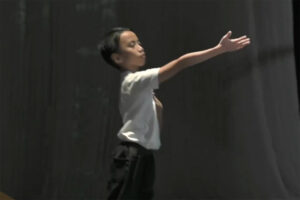Indigenous cradle songs for contemporary audiences

video for the hele
‘Gonon Klukab Tumabaga.’
FILIPINO PARENTS do not usually expose their young children to Philippine songs due to a lack of modern versions on newer platforms. This is a real shame since lullabies or cradle songs, known locally as hele, can help children become familiar with the sounds of their mother tongue as early as infancy.
This is something the Cultural Center of the Philippines (CCP) seeks to change.
At the recent launch of Himig Himbing: Mga Heleng Atin at the CCP’s Tanghalang Ignacio Gimenez, audiences both young and old got a soothing glimpse of eight reimagined Filipino lullabies and their accompanying music videos.
The project was conceptualized two years ago, shifting from being a book on hele from different parts of the country to a collection of songs that can be accessed online, according to Dennis N. Marasigan, the CCP’s artistic director.
“Makabago man ang mga tunog, hindi ito nawawala sa pinanggalingan na mga hele (Though it incorporates modern sounds, these songs do not stray far from the original cradle songs),” he said at the launch on Nov. 5.
A project of the CCP Arts Education Department, Himig Himbing’s16 chosen songs are based on research by ethnomusicologist Sol Trinidad and given new life by Krina Cayabyab’s musical arrangement.
Eight of the music videos for the songs were already released last year, while eight were premiered at the launch.
The filmmakers who created film interpretations of the second set of lullabies are all Cinemalaya alumnus: Arden Rod Condez, Zig Dulay, Christopher Gozum, Ida del Mundo, Vic Acedillo, Jr., Sheron Dayoc, Ma-an Asuncion-Dagñalan, and Jerrold Tarog.
Their respective additions to the collection are music videos of “Bata Alimahi,” a Cebuano-language Boholano lullaby; “Dandansoy,” a Hiligaynon song from Culasi, Antique; “Ligliway Ateng,” an indigenous lullaby from Pangasinan; “Gonon Klukab Tumabaga,” a B’laan lullaby first recorded in South Cotabato; “Tungas kay ta Sampaw,” a cradle song in the endangered Manobo Kinamigin language of Camiguin Island; “Uyug-uyug,” a Mansaka melody recorded in Davao del Norte; “O Matas a Banua,” a lullaby from Pampanga; and “Lubi-Lubi,” a Filipino cradle song recounting the months of the year.
CCP Board Trustee and Vice-Chair Michelle Nikki Junia, who initiated the idea, said: “The project is aimed at reintroducing the indigenous lullabies to contemporary audiences and developing nurturers who are grounded in Philippine songs and heles.”
The eight videos integrated folk culture, widespread Filipino issues, and beautiful visuals to add value to the lullabies. “In a short amount of time, these filmmakers are able to make the songs memorable,” Mr. Marasigan said.
The 16 songs in Himig Himbing: Mga Heleng Atin are now available on Spotify. Their music videos can be viewed on the CCP YouTube page. — Brontë H. Lacsamana




